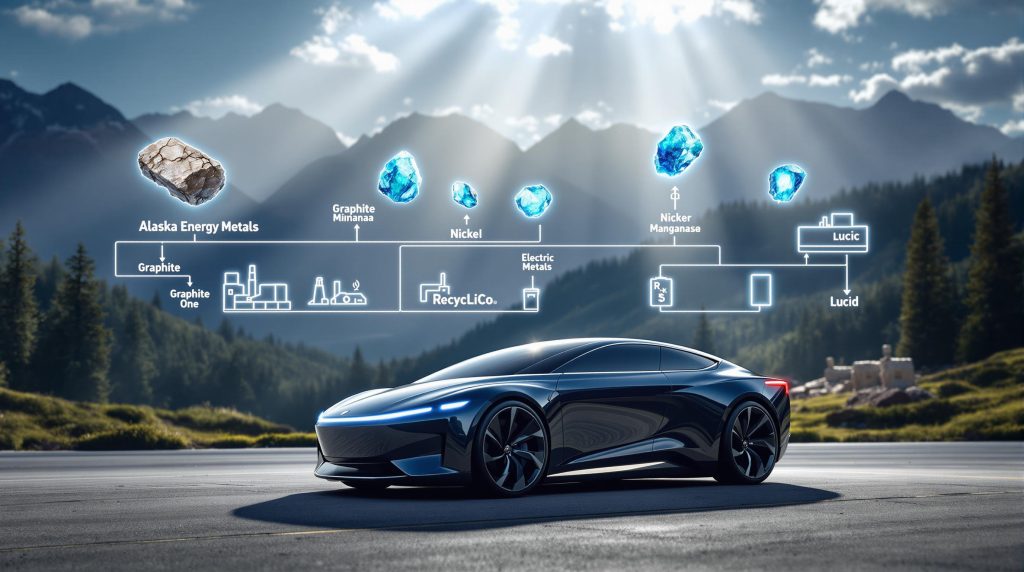Why Is Lucid Strengthening Its Critical Mineral Supply Chain?
The automotive industry is rapidly evolving, with electric vehicles (EVs) becoming increasingly mainstream. Behind this transition lies a complex web of supply chains for critical minerals essential to EV production. Lucid Motors is taking a bold approach to securing these vital resources through a groundbreaking initiative that could reshape how automakers source their materials.
Understanding the MINAC Collaboration Framework
The Minerals for National Automotive Competitiveness Collaboration (MINAC) represents a strategic partnership between Lucid Motors and four mineral producers focused on securing domestic supply chains for critical EV materials. Launched in August 2025 with a high-profile Washington D.C. roundtable, this initiative brings together key players in the mining industry innovation and automotive sectors.
The collaboration includes Alaska Energy Metals, Graphite One, Electric Metals, and RecycLiCo—each bringing specialized expertise in different critical minerals needed for EV production. What makes this partnership particularly noteworthy is the level of government engagement it has attracted, with participation from Arizona Governor Katie Hobbs, Senator Dan Sullivan (AK), and Representatives Nick Begich (AK) and Andy Biggs (AZ).
Marc Winterhoff, Interim CEO of Lucid Motors, emphasized the importance of this collaboration during the launch event: "Domestic supply chains strengthen manufacturing resilience, fortify sustainable supply chains, and accelerate job growth. Following in the footsteps of our previous agreements, today we are doubling down on our commitment to powering American innovation and look forward to working with our partners as we build the next generation of automotive manufacturing in the United States."
This initiative builds upon Lucid's existing relationships with mineral producers, including a previously established offtake agreement with Graphite One, demonstrating the company's ongoing commitment to securing domestic material sources.
What Are the Primary Objectives of This Mineral Supply Initiative?
MINAC has established several core objectives that guide its work toward transforming the critical minerals policy landscape for EVs:
- Establishing domestic supply agreements: Completing offtake agreements for American-sourced critical minerals to secure long-term material availability
- Barrier identification and resolution: Systematically identifying and addressing obstacles that currently impede domestic mineral supply chains
- Accelerating commercialization: Creating pathways for faster adoption of domestically produced materials in automotive manufacturing
- Enhancing cross-sector coordination: Improving communication and collaboration between mining companies and automotive manufacturers
- Supporting material qualification: Helping domestic suppliers meet the rigorous quality standards required by automakers and Tier 1 suppliers
The initiative takes a practical approach to these objectives, bringing together stakeholders from across the supply chain to coordinate efforts and develop solutions to long-standing challenges in material sourcing.
How Does Each Partner Contribute to the Mineral Supply Strategy?
Graphite One: Securing Essential Anode Materials
Graphite One stands as a critical partner in MINAC, developing multiple production facilities across the United States. The company is establishing synthetic graphite production in Ohio while also developing natural graphite resources in Northern Alaska—providing two distinct but complementary sources of this essential battery material.
Graphite is fundamental to lithium-ion battery anodes, and Lucid has already secured an offtake agreement with the company, demonstrating the automaker's forward-thinking approach to supply chain management. This dual-source strategy provides redundancy while keeping production entirely within U.S. borders.
Electric Metals USA: Advancing Manganese Development
Electric Metals USA brings another critical battery material to the collaboration through its Minnesota-based manganese project. Manganese plays an important role in lithium-ion battery cathodes, where it helps enhance energy density while simultaneously reducing overall battery production costs.
The company's focus on developing domestic manganese resources addresses a significant gap in U.S. battery material production capabilities. As cathode formulations continue to evolve, securing reliable manganese supplies becomes increasingly important for next-generation battery technologies.
Alaska Energy Metals: Establishing Nickel Security
Alaska Energy Metals is developing a major nickel project in Alaska that will help reduce U.S. dependency on foreign nickel sources. Nickel remains essential for high-performance cathodes in premium electric vehicles, making it a strategic priority for luxury EV manufacturers like Lucid.
The Alaskan project emphasizes responsible mining practices, aligning with both Lucid's sustainability goals and increasing consumer demand for ethically sourced materials. This partnership helps address one of the most significant supply vulnerabilities in the EV battery supply chain.
RecycLiCo: Integrating Recycling and Refining
RecycLiCo brings a unique dimension to the collaboration through its specialized hydrometallurgical technologies for processing both mined ore and recycled battery materials. This dual capability creates flexibility within the supply chain while supporting circular economy principles.
The company's processes efficiently recover battery-ready lithium, cobalt, nickel, and manganese from end-of-life batteries, creating a secondary supply stream that complements newly mined materials. This recycling component will become increasingly important as the first generation of mass-market EVs reaches end-of-life in the coming years, supporting various battery recycling initiatives across the industry.
What Benefits Does Domestic Mineral Sourcing Provide?
Shifting critical mineral sourcing to domestic suppliers offers multiple strategic advantages that extend beyond simple supply security:
- Enhanced manufacturing resilience: Reduced vulnerability to international shipping disruptions, trade disputes, and foreign policy changes
- Improved regulatory oversight: Materials produced under stringent U.S. environmental and labor regulations
- Greater supply chain transparency: Clearer visibility into material origins and production practices
- Economic development opportunities: Job creation across mining, processing, and manufacturing sectors
- Reduced geopolitical risk: Decreased dependency on nations with potentially misaligned interests
- Environmental impact control: Higher environmental standards compared to many foreign operations
Gregory Beischer, President & CEO of Alaska Energy Metals, highlighted these advantages during the MINAC launch: "Sourcing minerals domestically enables better regulatory oversight, higher environmental standards, metal source traceability, and responsible sourcing. This approach mitigates harmful environmental and human rights risks often associated with foreign mining operations and provides an opportunity to improve the livelihoods of American communities."
How Does This Initiative Address Current Supply Chain Vulnerabilities?
The U.S. critical mineral supply chain currently faces several significant challenges that the MINAC initiative aims to address:
- Extreme foreign dependency: Heavy reliance on imported minerals, particularly from China and other nations that may have competing interests
- Limited processing infrastructure: Insufficient domestic capacity to refine and process raw materials into battery-grade components
- Complex regulatory environment: Navigating permitting processes for new mining and processing operations
- Underdeveloped transportation networks: Logistical challenges in moving materials from mining sites to manufacturing facilities
- Investment shortfalls: Insufficient capital allocation for developing domestic mineral resources
- Workforce limitations: Shortage of specialized technical expertise for advanced mineral processing
MINAC addresses these vulnerabilities through a coordinated approach that combines long-term offtake agreements, collaborative problem-solving, and direct engagement with government stakeholders. By bringing together companies from different points in the supply chain, the initiative creates opportunities to identify and resolve bottlenecks that might otherwise persist.
The focus on expanding coordination between U.S. mining and automotive sectors represents a significant shift from the traditionally siloed approach to these industries. This integration enables more effective planning and investment in critical infrastructure needed to support domestic mineral strategies.
What Makes This Collaboration Strategically Significant?
Lucid's leadership in forming the MINAC initiative positions the company at the forefront of efforts to transform automotive supply chains. This proactive stance provides several strategic advantages:
- Competitive positioning: Early access to limited domestic mineral resources
- Policy influence: Active participation in shaping emerging regulations and incentives
- Supply chain differentiation: Potential marketing advantage from responsibly sourced materials
- Innovation catalyst: Driving development of new extraction and processing technologies
- Resilience building: Establishing supply security ahead of potential disruptions
- Industry leadership: Setting standards that may influence broader automotive practices
The timing of this initiative aligns with increasing government focus on critical minerals energy security, including various incentives designed to accelerate domestic production. By establishing these partnerships now, Lucid gains first-mover advantages in what is likely to become an increasingly competitive landscape for securing battery materials.
The collaboration also creates opportunities to influence technical standards and specifications for battery materials, potentially helping shape industry direction in ways that align with Lucid's manufacturing requirements and sustainability goals, as reported by PR Newswire.
How Does This Compare to Global Automotive Supply Chain Strategies?
The MINAC initiative represents a distinctly American approach to battery supply chain challenges, though it shares some similarities with efforts in other regions:
- European parallels: The European Battery Alliance takes a similar collaborative approach but with greater emphasis on government coordination
- Asian contrasts: China's strategy emphasizes state-led vertical integration and overseas resource acquisition
- North American context: Alignment with U.S. and Canadian policies promoting regional mineral security
- Distinctive features: Stronger emphasis on private-sector leadership with government support rather than government-led initiatives
This approach reflects the U.S. market's preference for industry-led solutions while acknowledging the critical role of supportive government policies. The involvement of elected officials from both parties suggests the potential for bipartisan support for domestic mineral development initiatives.
Unlike some international approaches that focus primarily on securing foreign resources, the MINAC strategy emphasizes developing resources within U.S. borders—creating both supply security and domestic economic benefits.
What Do Mineral Producers See as Key Benefits?
For the mineral producers participating in the MINAC initiative, the collaboration offers several compelling advantages:
- Market certainty: Long-term offtake agreements provide predictable demand
- Development acceleration: Partnership with a major automaker can help secure financing
- Technical alignment: Direct communication ensures production meets automotive specifications
- Shared problem-solving: Collaborative approach to overcoming regulatory and logistical challenges
- Enhanced visibility: Association with prominent automotive brands raises profile with investors
Gregory Beischer of Alaska Energy Metals emphasized the social and environmental benefits: "This approach mitigates harmful environmental and human rights risks often associated with foreign mining operations and provides an opportunity to improve the livelihoods of American communities."
For these companies, the partnership provides a clearer path to market and potentially accelerates project development timelines. The ability to collaborate directly with an end-user helps ensure their production capabilities align with actual market needs.
What Challenges Must Be Overcome for Success?
Despite its promising approach, the Lucid and mineral supply chain collaboration faces several significant challenges that will need to be addressed:
- Development timelines: New mining operations typically require 5-10 years from discovery to production
- Capital requirements: Establishing domestic processing facilities requires substantial investment
- Technical hurdles: Meeting stringent automotive specifications with new material sources
- Regulatory navigation: Addressing complex and sometimes lengthy permitting processes
- Global competition: Continuing race for limited mineral resources worldwide
- Integration complexities: Qualifying and incorporating new materials into established manufacturing processes
The initiative's success will depend on effectively addressing these challenges through persistent collaboration, strategic investment, and innovative approaches to regulatory and technical obstacles. The involvement of government officials suggests potential for policy support, but concrete regulatory reforms may be needed to fully realize the initiative's goals, according to Supply Chain Dive.
The long-term nature of mineral development projects also means that results will emerge gradually rather than immediately, requiring sustained commitment from all partners.
FAQ: Critical Minerals for Electric Vehicles
How will domestic mineral sourcing affect vehicle costs?
While initial investments in domestic infrastructure may increase short-term costs, long-term benefits include reduced transportation expenses, lower supply chain risks, and potential tax incentives that could stabilize component pricing. The emphasis on reducing dependency on volatile international markets could ultimately lead to more predictable pricing for both manufacturers and consumers.
When will U.S. consumers see fully domestic-sourced EVs?
Complete domestic supply chains will develop gradually over the next 5-10 years, with certain minerals becoming available sooner based on existing infrastructure and geological availability within the United States. Graphite from domestic sources may be incorporated relatively quickly, while other materials like nickel and manganese will likely take longer to reach production scale.
Which critical minerals present the greatest supply challenges?
Lithium, nickel, cobalt, and graphite currently face the most significant supply constraints, with each presenting unique challenges in terms of geographic concentration, processing requirements, and market dynamics. Nickel suitable for batteries is particularly challenging to source from environmentally responsible operations, making domestic development especially valuable.
How does recycling fit into the long-term mineral strategy?
Recycling is expected to provide an increasing percentage of critical minerals, potentially supplying 25-30% of battery material needs by 2035 as first-generation EVs reach end-of-life and recycling technologies mature. RecycLiCo's participation in MINAC highlights the importance of this complementary approach to mineral sourcing.
What role will government policy play in supporting these initiatives?
Federal and state policies, including tax incentives, grants, loan guarantees, and streamlined permitting processes, will be crucial for accelerating domestic mineral development and processing capabilities. The bipartisan participation in the MINAC launch event suggests potential for policy support that transcends political divisions.
Further Exploration:
Readers interested in learning more about automotive mineral supply chains can explore related educational content from Lucid Motors' official website, which offers additional perspectives on sustainable manufacturing initiatives.
Want to Capitalise on the Next Major Mineral Discovery?
Stay ahead of the market with instant alerts on significant ASX mineral discoveries through Discovery Alert's proprietary Discovery IQ model, which transforms complex announcements into actionable trading opportunities. Explore why major mineral discoveries can lead to exceptional returns by visiting Discovery Alert's dedicated discoveries page and begin your 30-day free trial today.




